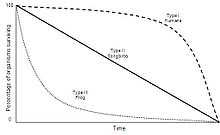Survivorship curve

A survivorship curve is a graph showing the number or proportion of individuals surviving at each age for a given species or group (e.g. males/females). Survivorship curves can be constructed for a given cohort (a group of individuals of roughly the same age) based on a life table.
There are three generalized types of survivorship curves, which are simply referred to as Type I, Type II and Type III curves.
- Type I survivorship curves are characterized by high survival in early and middle life, followed by a rapid decline in survivorship in later life. Humans are one of the species that show this pattern of survivorship.
- Type II curves are an intermediate between Type I and III, where roughly constant mortality rate is experienced regardless of age. Some birds follow this pattern of survival.
- In Type III curves, the greatest mortality is experienced early on in life, with relatively low rates of death for those surviving this bottleneck. This type of curve is characteristic of species that produce a large number of offspring (see r/K selection theory). One example of a species that follows this type of survivorship curve is the Octopus.
The number or proportion of organisms surviving is plotted on the y-axis, generally with a logarithmic scale starting with 1000 individuals, while their age, often as a proportion of maximum life span, is plotted on the x-axis.
In mathematical statistics, the survival function is one specific form of survivorship curve and plays a basic part in survival analysis.
See also
References
- Campbell, Neil A.; Reece, Jane B. (2005). Biology. Benjamin Cummings. pp. 1177 pp. ISBN 0-8053-7146-X.